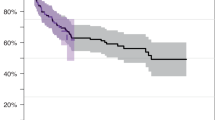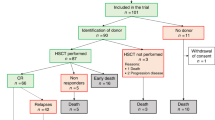Summary:
The overall survival of patients with advanced multiple myeloma (MM) undergoing high-dose chemotherapy and autologous stem cell transplantation (SCT) depends mainly on the quality of response. Thus, to improve the response rate, a new intensified high-dose chemoradiotherapy was evaluated in a phase I/II study. After induction chemotherapy, 89 patients (median age 51 years, range 32–60 years) with MM stage II/III received a conditioning regimen with total marrow irradiation (9 Gy), busulfan (12 mg/kg) and cyclophosphamide (120 mg/kg) followed by SCT. Regimen-related toxicity according to WHO criteria and response rates defined by EBMT/IBMTR were analyzed. The main toxicity was mucositis grade III/IV in 76%, and fever grade >I in 75% of patients. Three patients developed reversible veno-occlusive disease. Transplant-related mortality was 2%. Among patients with de novo and pretreated MM, a CR rate of 48 and 41%, respectively, was documented. With a median follow-up of 45 months, the actuarial median durations of event-free survival (EFS) and overall survival (OS) after transplant were 29 and 61 months for the whole group, 36 and 85 months for patients with de novo MM, respectively. Thus, administration of this intensified conditioning regimen was associated with tolerable toxicity, a high response rate and long EFS and OS.
This is a preview of subscription content, access via your institution
Access options
Subscribe to this journal
Receive 12 print issues and online access
$259.00 per year
only $21.58 per issue
Buy this article
- Purchase on Springer Link
- Instant access to full article PDF
Prices may be subject to local taxes which are calculated during checkout


Similar content being viewed by others
References
Boccadoro M, Pileri A . Diagnosis, prognosis, and standard treatment of multiple myeloma. Clin Haematol Oncol N Am 1997; 11: 111–131.
Barlogie B . Plasma cell myeloma. In: Kipps T (ed.). Haematology. William's Haematology, 5th edn. McGraw-Hill: Baltimore, MD, 1995, pp 1109–1130.
Boccadoro M, Marmont F, Tribalto M et al. Multiple myeloma: VMCP/VBAP alternating combination chemotherapy is not superior to melphalan and prednisone even in high-risk patients. J Clin Oncol 1991; 9: 444–448.
McElwain TJ, Powles RJ . High-dose intravenous melphalan for plasma-cell leukaemia and myeloma. Lancet 1983; 2: 822–824.
Fefer A, Cheever MA, Greenberg PD . Identical-twin (syngeneic) marrow transplantation for haematologic cancers. J Natl Cancer Inst 1986; 76: 1269–1273.
Barlogie B, Hall R, Zander A et al. High-dose melphalan with autologous bone marrow transplantation for multiple myeloma. Blood 1986; 67: 1298–1301.
Fermand JP, Levy Y, Gerota J et al. Treatment of aggressive multiple myeloma by high-dose chemotherapy and total body irradiation followed by blood stem cells autologous graft. Blood 1989; 73: 20–23.
Alexanian R, Dimopoulos MA, Hester J et al. Early myeloablative therapy for multiple myeloma. Blood 1994; 84: 4278–4282.
Attal M, Harousseau JL, Stoppa AM et al. A prospective, randomised trial of autologous bone marrow transplantation and chemotherapy in multiple myeloma, Intergroupe Francais du Myelome. N Engl J Med 1996; 335: 91–97.
Barlogie B, Jagannath S, Vesole DH et al. Superiority of tandem autologous transplantation over standard therapy for previously untreated multiple myeloma. Blood 1997; 89: 789–793.
Lenhoff S, Hjorth M, Holmberg E et al. Impact on survival of high-dose therapy with autologous stem cell support in patients younger than 60 years with newly diagnosed multiple myeloma: a population-based study. Blood 2000; 95: 7–11.
Petersen FB, Buckner CD, Appelbaum FR et al. Busulfan, cyclophosphamide and fractionated total body irradiation as a preparatory regimen for marrow transplantation in patients with advanced haematological malignancies: a phase I study. Bone Marrow Transplant 1989; 4: 617–623.
Lynch MH, Petersen FB, Appelbaum FR et al. Phase II study of busulfan, cyclophosphamide and fractionated total body irradiation as a preparatory regimen for allogeneic bone marrow transplantation in patients with advanced myeloid malignancies. Bone Marrow Transplant 1995; 15: 59–64.
Bensinger WI, Rowley SD, Demirer T et al. High-dose therapy followed by autologous haematopoietic stem-cell infusion for patients with multiple myeloma. J Clin Oncol 1996; 5: 1447–1456.
Durie BGM, Salmon S . A clinical staging system for multiple myeloma, Correlation of measured myeloma cell mass with presenting clinical features, response to treatment, and survival. Cancer 1975; 36: 842–854.
Blade J, Samson D, Reece D et al. Criteria for evaluating disease response and progression in patients with multiple myeloma treated by high dose therapy and haemopoietic stem cell transplantation. Myeloma Subcommittee of the EBMT. Br J Haematol 1998; 102: 1115–1123.
Keys A, Fidanza F, Karvonen MJ et al. Indices of relative weight and obesity. J Chronic Dis 1972; 25: 329–343.
Tarella C, Caracciolo D, Gavarotti P et al. Overweight as an adverse prognostic factor for non-Hodgkin's lymphoma patients receiving high-dose chemotherapy and autograft. Bone Marrow Transplant 2000; 26: 1185–1191.
Vesole DH, Tricot G, Jagannath S et al. Autotransplants in multiple myeloma: what have we learned? Blood 1996; 88: 838–847.
Weaver CH, Zhen B, Schwartzberg LS et al. Phase I–II evaluation of rapid sequence tandem high-dose melphalan with peripheral blood stem cell support in patients with multiple myeloma. Bone Marrow Transplant 1998; 22: 245–251.
Jagannath S, Vesole DH, Glenn L et al. Low-risk intensive therapy for multiple myeloma with combined autologous bone marrow and blood stem cell support. Blood 1992; 80: 1666–1672.
Cunningham D, Paz-Ares L, Gore ME et al. High-dose melphalan for multiple myeloma: long term follow-up data. J Clin Oncol 1994; 12: 764–768.
Fermand JP, Chevret S, Ravaud P et al. High-dose chemoradiotherapy and autologous blood stem cell transplantation in multiple myeloma: results of a phase II trial involving 63 patients. Blood 1993; 82: 2005–2009.
Goldschmidt H, Hegenbart U, Wallmeier M et al. Peripheral blood progenitor cell transplantation in multiple myeloma following high-dose melphalan-based therapy. Recent Res Clin Cancer 1998; 144: 27–35.
Desikan KR, Tricot G, Dhodapkar M et al. Melphalan plus total body irradiation (MEL-TBI) or cyclophosphamide (MEL-CY) as a conditioning regimen with second autotransplant in responding patients with myeloma is inferior compared to historical controls receiving tandem transplants with melphalan alone. Bone Marrow Transplant 2000; 25: 483–487.
Moreau P, Facon T, Attal M et al. Comparison of 200 mg/m2 melphalan and 8 Gy total body irradiation plus 140 mg/m2 melphalan as conditioning regimens for peripheral blood stem cell transplantation in patients with newly diagnosed multiple myeloma: final analysis of the Intergroupe Francophone du Myelome 9502 randomized trial. Blood 2002; 99: 731–735.
Lehnert S, Greene D, Batist G . Radiation resistance in a melphalan-resistant subline of a rat mammary carcinoma. Radiat Res 1994; 139: 232–239.
Louie KG, Behrens BC, Kinsella TJ et al. Radiation survival parameters of antineoplastic drug-sensitive and -resistant human ovarian cancer cell lines and their modification by buthionine sulfoximine. Cancer Res 1985; 45: 2110–2115.
Barlogie B, Jagannath S, Desikan KR et al. Total therapy with tandem transplants for newly diagnosed multiple myeloma. Blood 1999; 93: 55–65.
Acknowledgements
This work was supported by a grant by the Deutsche Forschungsgemeinschaft (SFB 120 project B1), by the Jose Carreras Foundation Against Leukemia and the National Institutes of Health Grant CA 47748.
Author information
Authors and Affiliations
Rights and permissions
About this article
Cite this article
Einsele, H., Bamberg, M., Budach, W. et al. A new conditioning regimen involving total marrow irradiation, busulfan and cyclophosphamide followed by autologous PBSCT in patients with advanced multiple myeloma. Bone Marrow Transplant 32, 593–599 (2003). https://doi.org/10.1038/sj.bmt.1704192
Received:
Accepted:
Published:
Issue Date:
DOI: https://doi.org/10.1038/sj.bmt.1704192
Keywords
This article is cited by
-
Bortezomib-based strategy with autologous stem cell transplantation for newly diagnosed multiple myeloma: a phase II study by the Japan Study Group for Cell Therapy and Transplantation (JSCT-MM12)
International Journal of Clinical Oncology (2019)
-
Combination of high-dose melphalan and bortezomib as conditioning regimen for autologous peripheral blood stem cell transplantation in multiple myeloma
International Journal of Hematology (2013)
-
Contamination of autologous peripheral blood progenitor cell grafts predicts overall survival after high-dose chemotherapy in multiple myeloma
Journal of Cancer Research and Clinical Oncology (2009)
-
Predictive factors for survival in myeloma patients who undergo autologous stem cell transplantation: a single-centre experience in 211 patients
Bone Marrow Transplantation (2006)
-
Efficacy of diverse high-dose regimens followed by autologous peripheral blood stem cell transplantation in consecutive multiple myeloma patients: a single-centre analysis over a 12-year period
Annals of Hematology (2006)



